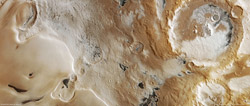Icy Promethei Planum

Promethei Planum, an area seasonally covered with layer of ice more than 3500 m thick layer of ice in the martian south polar region, was the subject of the High Resolution Stereo Camera’s focus on 22 September 2005 as Mars Express was in orbit above the Red Planet. Promethei Planum lies at approximately 76° south and 105° east. An approximately 100 km-large and 800 m-deep impact crater is visible in the northern part of the image. The crater’s interior is partly covered in ice. In the centre of the image are structures that may have been created by basaltic lava flow from a volcano. This area is covered in ice. The dark dunes towards the bottom of the image are most likely made up of dust originating from this lava flow or volcanic ash. A broad sheet of ice, which is an extension of the south polar ice cap is located south of the lava flow, to the left in the (nadir) image. The steep flanks clearly show white, clean ice. The thickness of the ice is between 900 and 1100 m. Credits: ESA/ DLR/ FU Berlin (G. Neukum)
Promethei Planum lies at approximately 76° south and 105° east on the Red Planet. The image data acquired in the region has a ground resolution of approximately 40 m/pixel. An impact crater that is approximately 100 km wide and 800 m deep is visible in the northern part of the image. The crater’s interior is partly covered in ice.
In the centre of the image are structures that may have been created by basaltic lava flow from a volcano. This area is covered in ice. The dark dunes towards the bottom of the image are most likely made up of dust originating from this lava flow or volcanic ash.
A broad sheet of ice, which is an extension of the south polar ice cap is located south of the lava flow, to the left in the (nadir) image. The steep flanks clearly show white, clean ice. The thickness of the ice is between 900 and 1100 m.
Latest results from the Mars Advanced Radar for Ionosphere and Subsurface Sounding (MARSIS) onboard Mars Express have revealed that the thickness of this extension of the south polar ice cap exceeds 3500 m. The total amount of water ice contained at both the south and north poles of Mars makes up the largest water reservoir on the planet today.
If polar ice melted, the entire surface of the planet would be covered by an ocean 11-m deep.
The colour scenes have been derived from the three High Resolution Stereo Camera (HRSC) colour channels and the nadir channel. The perspective views have been calculated from the digital terrain model derived from the stereo channels.
The anaglyph image was calculated from the nadir and one stereo channel, stereoscopic glasses are required to view it.
The black and white high resolution images were derived form the nadir channel which provides the highest detail of all channels.
Media Contact
More Information:
http://www.esa.int/SPECIALS/Mars_Express/SEMEX9M5NDF_0.htmlAll latest news from the category: Physics and Astronomy
This area deals with the fundamental laws and building blocks of nature and how they interact, the properties and the behavior of matter, and research into space and time and their structures.
innovations-report provides in-depth reports and articles on subjects such as astrophysics, laser technologies, nuclear, quantum, particle and solid-state physics, nanotechnologies, planetary research and findings (Mars, Venus) and developments related to the Hubble Telescope.
Newest articles

Parallel Paths: Understanding Malaria Resistance in Chimpanzees and Humans
The closest relatives of humans adapt genetically to habitats and infections Survival of the Fittest: Genetic Adaptations Uncovered in Chimpanzees Görlitz, 10.01.2025. Chimpanzees have genetic adaptations that help them survive…

You are What You Eat—Stanford Study Links Fiber to Anti-Cancer Gene Modulation
The Fiber Gap: A Growing Concern in American Diets Fiber is well known to be an important part of a healthy diet, yet less than 10% of Americans eat the minimum recommended…

Trust Your Gut—RNA-Protein Discovery for Better Immunity
HIRI researchers uncover control mechanisms of polysaccharide utilization in Bacteroides thetaiotaomicron. Researchers at the Helmholtz Institute for RNA-based Infection Research (HIRI) and the Julius-Maximilians-Universität (JMU) in Würzburg have identified a…



